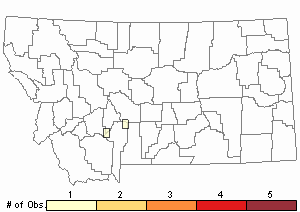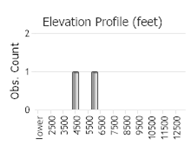View in other NatureServe Network Field Guides
NatureServe
Montana
Utah
Wyoming
Idaho
Wisconsin
British Columbia
South Carolina
Yukon
California
New York
Three-nerved Goldenrod - Solidago velutina
Other Names:
Solidago sparsiflora
State Rank Reason (see State Rank above)
Few-flowered goldenrod is known in Montana from 1 specimen collection from the Stillwater River Valley, which lacks precise locality data. Other reports of this species from the state are based on mis-identified specimens. Additional data are needed.
General Description
Few-flowered Goldenrod is an herbaceous perennial with ascending stems that are 3-6 dm high and arising from a branched rootcrown. The alternate, narrowly lance-shaped leaves have indistinct petioles and entire to shallowly toothed margins. The mid-stem leaves are 4-10 cm long, and are the largest of the leaves; they have 3 distinct main nerves. The foliage is grayish short-hairy. Short-stalked flower heads are borne on a few 1-sided spikes in a terminal, open, nodding inflorescence. The heads are 4-6 mm high and have 3-4 series of narrow, pointed involucral bracts, ca. 8 yellow rays that are 3-4 mm long, and ca. 8 yellow disk flowers. The achene has a pappus at its summit.
Our plants are subspecies sparsiflora (A.Gray) Semple.
Phenology
Flowering occurs in August.
Diagnostic Characteristics
Among our plains goldenrods with a similar growth form, well-developed stem leaves, and basal leaves lacking or small, few-flowered goldenrod is distinguished by having leaves over 1 cm wide, stems pubescent, at least below the inflorescence, and involucral bracts that are mostly broadest at the base and sharp-tipped. In addition, S. canadensis has smaller (1-4 mm) and more numerous ray flowers.
Range Comments
Valleys of Stillwater County. OR to MT south to CA, AZ, NM, TX and Mexico (Lesica et al. 2012. Manual of Montana Vascular Plants. BRIT Press. Fort Worth, TX).
Observations in Montana Natural Heritage Program Database
Number of Observations: 2
(Click on the following maps and charts to see full sized version)
Map Help and Descriptions
Relative Density

Recency



 (Observations spanning multiple months or years are excluded from time charts)
(Observations spanning multiple months or years are excluded from time charts)
Habitat
Throughout its range, the species is found on sandy, well-drained soils of unglaciated broken and rolling plains in a variety of semi-open settings, including open woods, woodland margins and rocky slopes (Great Plains Flora Assoc. 1986). Montana records have come from sagebrush habitat and an open area near a cultivated field possibly at the head of a woody draw.
Ecology
Solidagos are wind-pollinated and have seeds that disperse by wind. Few-flowered goldenrod is one of many that reproduce vegetatively by rhizomes, forming clonal clumps. The dry, continental climate in which this species grows is moderated at least in part by tree cover and/or moisture-accumulating fractures in sandstone bedrock (Heidel 1994). Similar species of goldenrod have very deep taproots. Galls that reduce vigor but do not kill plants are very common in goldenrods, and some are species-specific.
Management
The plant is highly palatable and may be subject to herbivory by mule and white-tailed deer (Austin and Urness 1986).
Stewardship Responsibility
References
- Literature Cited AboveLegend:
 View Online Publication
View Online Publication Lesica, P., M.T. Lavin, and P.F. Stickney. 2012. Manual of Montana Vascular Plants. Fort Worth, TX: BRIT Press. viii + 771 p.
Lesica, P., M.T. Lavin, and P.F. Stickney. 2012. Manual of Montana Vascular Plants. Fort Worth, TX: BRIT Press. viii + 771 p.
- Additional ReferencesLegend:
 View Online Publication
View Online Publication
Do you know of a citation we're missing? Lesica, P., M.T. Lavin, and P.F. Stickney. 2022. Manual of Montana Vascular Plants, Second Edition. Fort Worth, TX: BRIT Press. viii + 779 p.
Lesica, P., M.T. Lavin, and P.F. Stickney. 2022. Manual of Montana Vascular Plants, Second Edition. Fort Worth, TX: BRIT Press. viii + 779 p.
- Web Search Engines for Articles on "Three-nerved Goldenrod"





